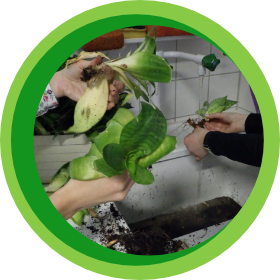Grow your own seedlings

Some plants must be pre-cultivated before they are planted. A practical and cost-saving option is to grow plants from the seeds yourself. This way, in contrast to greenhouse plants, they are immediately adapted to the environmental conditions and are thus more robust. This experiment is an exemplary instruction using tomatoes as an example; of course, other plants can also be chosen.
LEARNING GOALS

Pupils can:
- name the most important growth factors for plants
- derive measures for the successful cultivation of young plants from these factors
- carry out the plant cultivation experiment according to instructions, document and evaluate their observations
- interpret the results of the plant cultivation
Background Information
Subjects: Biology and Environmental Studies, Handicrafts Education, Nutritional Sciences
Required Materials: tomato seeds, growing soil, growing pots or alternative re-used material, shallow trays/coasters for growing pots, transparent film for covering, spray bottle, flowerpots
Required premises/equipment of the rooms: classroom or schoolyard
Ideal for: large group
Time required: approx. 1 teaching unit (can be extended)
Preparation
- Check the ideal seedtime for the chosen plant species for this exercise. For tomatoes, this would be the end of February to mid-March. If a school garden is available, you can also choose plants that you can sow directly outdoors later. However, for observation, sowing in pots in the classroom is ideal.
- Think about a suitable place for the seed pots. The optimal germination temperature for tomatoes is 20 to 22°C. Avoid placing it in the immediate vicinity of the heating.
- Consider the period of growth and what you will do with the young plants. Is there a possibility to put them in a bed in the school garden or should the plants grow in pots? Or will the pupils take them home later?
Tasks in class
- As an introduction, discuss the topic of growth factors for plants. The initial questions could be: We want to grow our own plants for the greening of our school. How do we have to proceed? What do we need for this? What do the plants need to develop well? Which plants do we want to choose?
- As a first step pupils fill the seed pots 1 to 2 cm below the top with loose soil.
- Next, the pupils place a few seeds 3 cm apart in each seed pot. They sprinkle them with a loose layer of soil, which should only be about two to four times as thick as the seed is tall.
- Now moisten the potting soil. The spray bottle is suitable for this.
- Finally, the seed pots are sealed with cling film and placed on the windowsill where they receive sufficient light. The light causes the liquid to rise from the soil, creating a greenhouse atmosphere under the film.
- Discuss the care with the students and create a watering plan together.
- The pupils now observe the growth. The following questions can be discussed:
- How do the first two leaves of the tomatoes (the cotyledons) differ from the leaves that come later?
- Why do the seedlings grow at different rates within a pot even though they have the same conditions?
- The growth can be documented by drawing, by photographs or written reports.
- As soon as the first two to four pairs of leaves have grown (after about three weeks), you can start separating the cuttings that are too close together, the so-called pricking out. The strongest plants are re-potted into their own flowerpots. Use a sharpened wooden stick to carefully lift the seedlings and their roots out of the soil. Sick and weak plants are sorted out.
- Depending on the regional climate and temperatures, the tomatoes can be planted outside (in Austria approx. mid May). Frost should be avoided in any case. Tomatoes are sun worshippers, but too strong midday heat and wind will get to them. After planting, they should be placed at an appropriately protected and bright spot.
- Towards the end of the school year, using the initial questions and protocols, the results can be interpreted, and the process of the exercise can be discussed. How well did the care of the seedlings work?
HINT

- Empty egg cartons can also be used instead of seed trays and cups (e.g. from yoghurt, don’t forget to make holes in the bottom).
- It is also possible to mix your own seeding soil. The best soil for growing tomatoes is: compost (25 %), garden soil (15 %), coconut fibre/perlite (40 %), bark humus (10 %) and sand (10 %).
HINT

The soil should always be kept moist, but there should be no waterlogging.
HINT

Tomatoes also grow in large pots. If you do not have a schoolyard with space for a bed, you can use large pots (between eight and ten litres), mortar tubs or buckets instead. Just consider that the bottom should have holes to prevent waterlogging when it rains or when the plants are watered.
